Abstract
The present study reports the changes in configuration of maximal flow-volume curves after eight weeks' treatment with inhaled corticosteroids in 14 asthmatic patients. The configuration was compared with that seen after bronchodilatation following inhalation of a single dose of ipratropium bromide. After inhaled corticosteroids the shape of the flow-volume curves was less bowed toward the volume axis, whereas the shape of the flow-volume curves after inhalation of ipratropium bromide showed no significant change. A significant correlation was observed between the decrease in blood eosinophil cell count and the straightening of the flow-volume curves, quantitatively expressed as shape factor and slope ratio. It is concluded that these changes in flow-volume curve configuration reflect a decrease in inhomogeneously distributed inflammatory airway narrowing.
Full text
PDF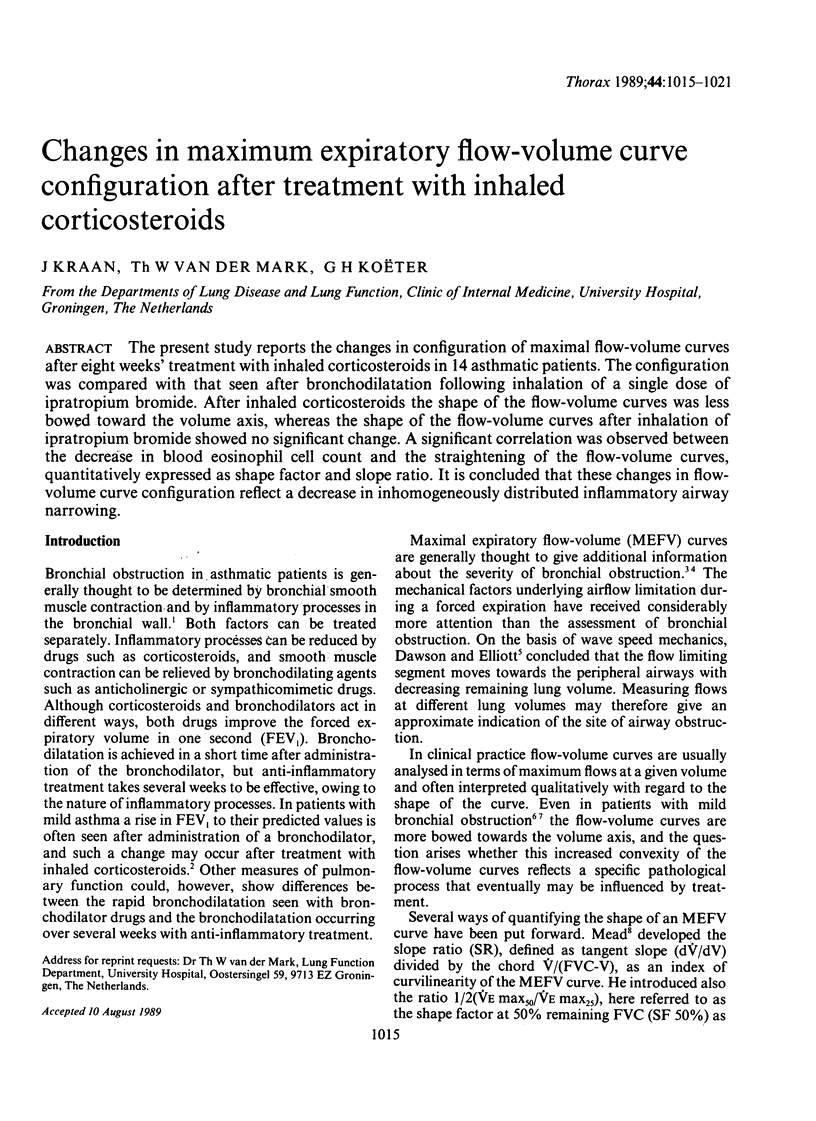
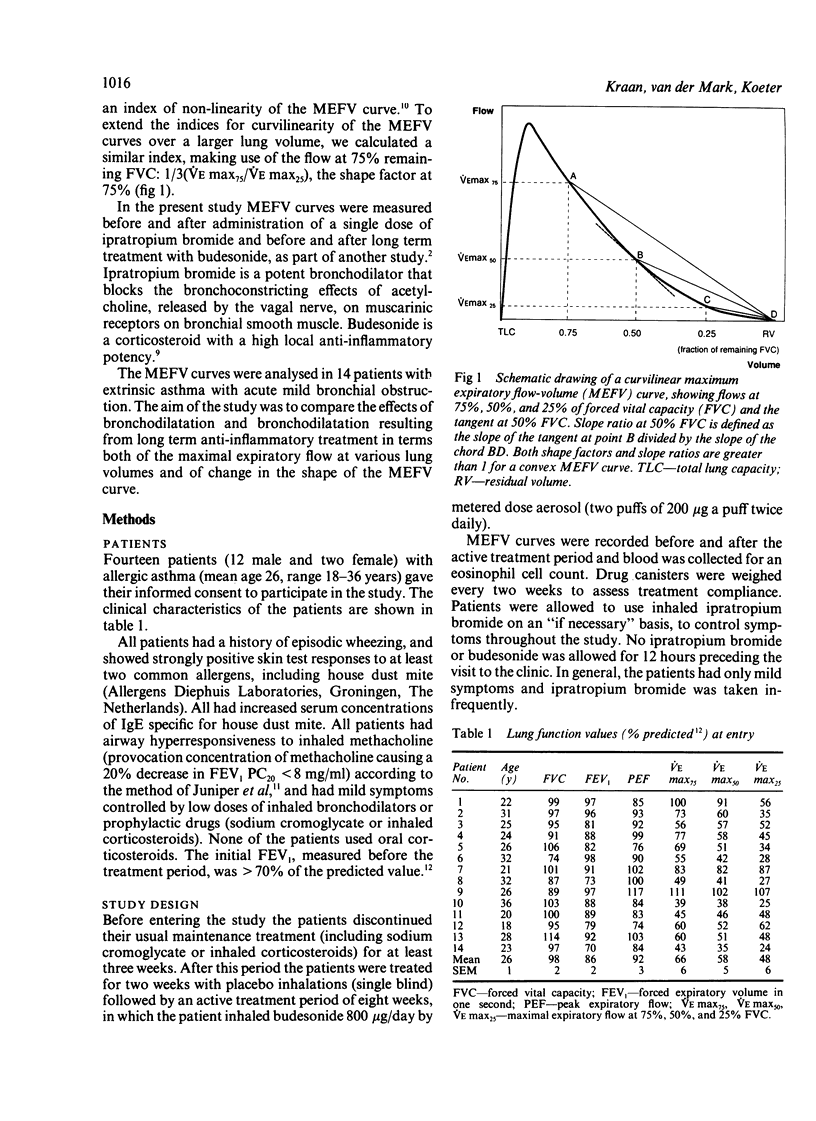
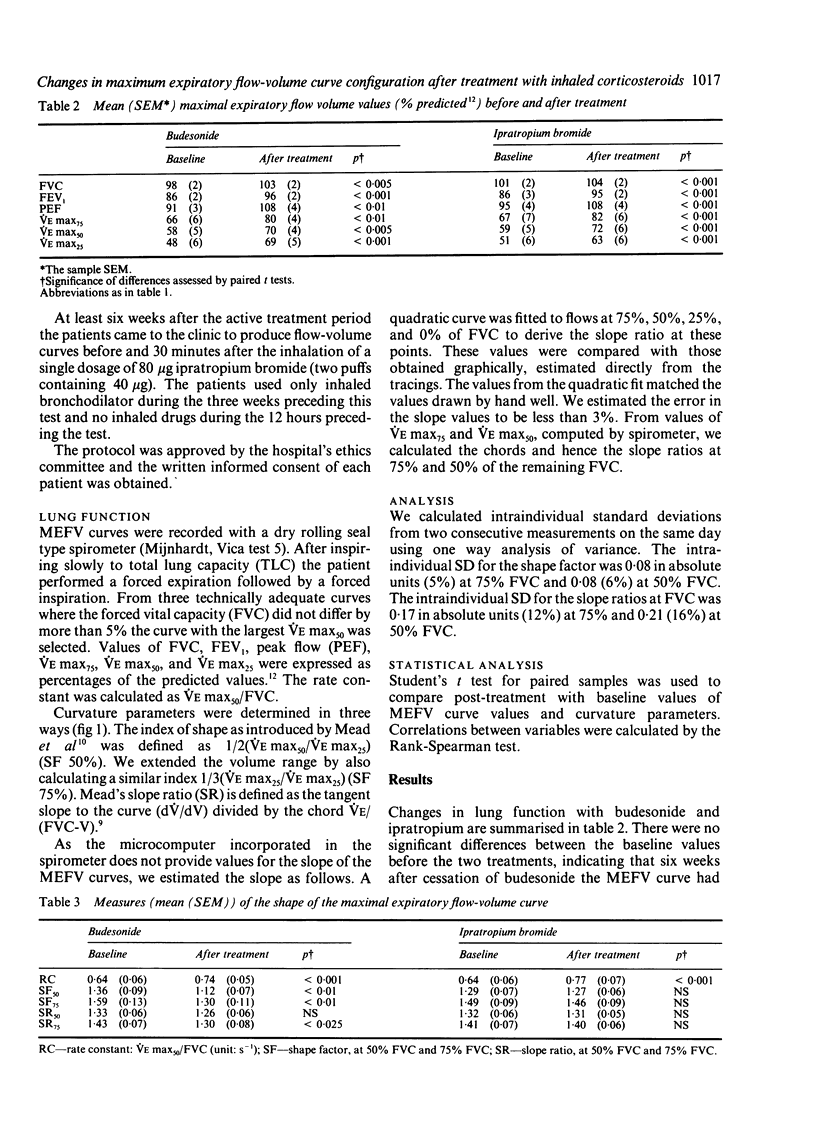
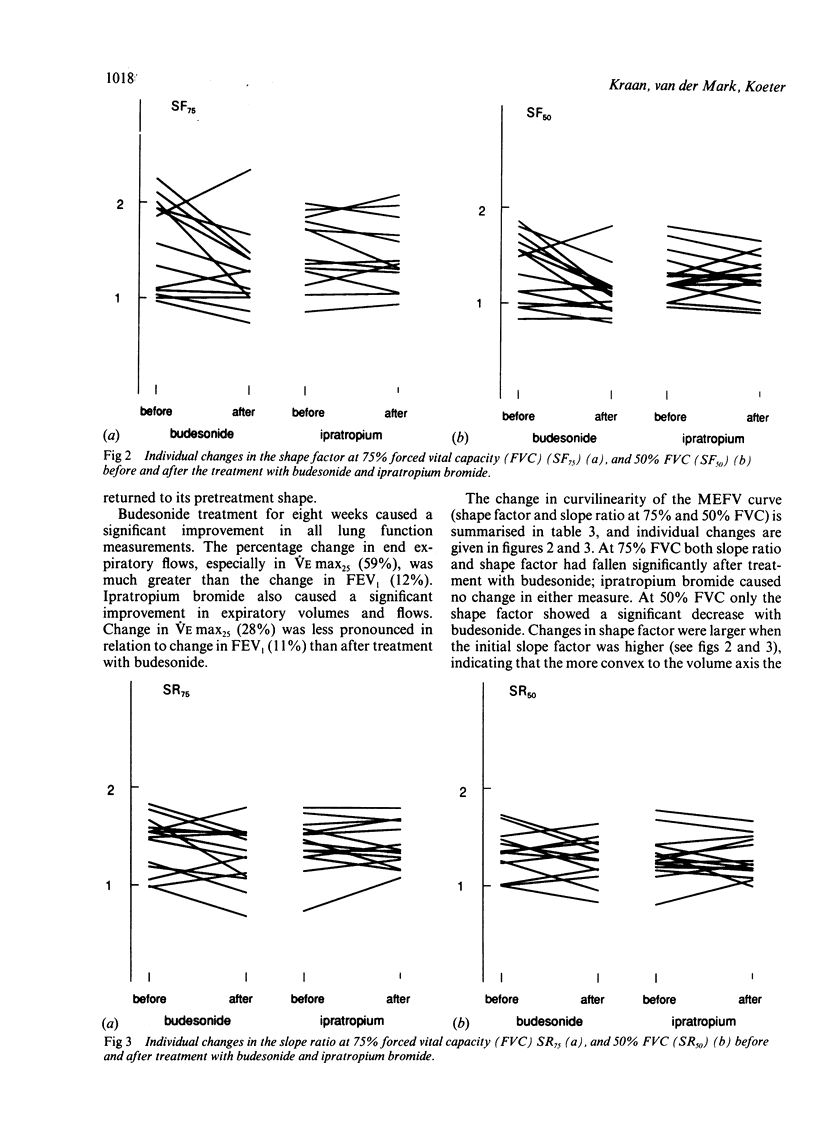
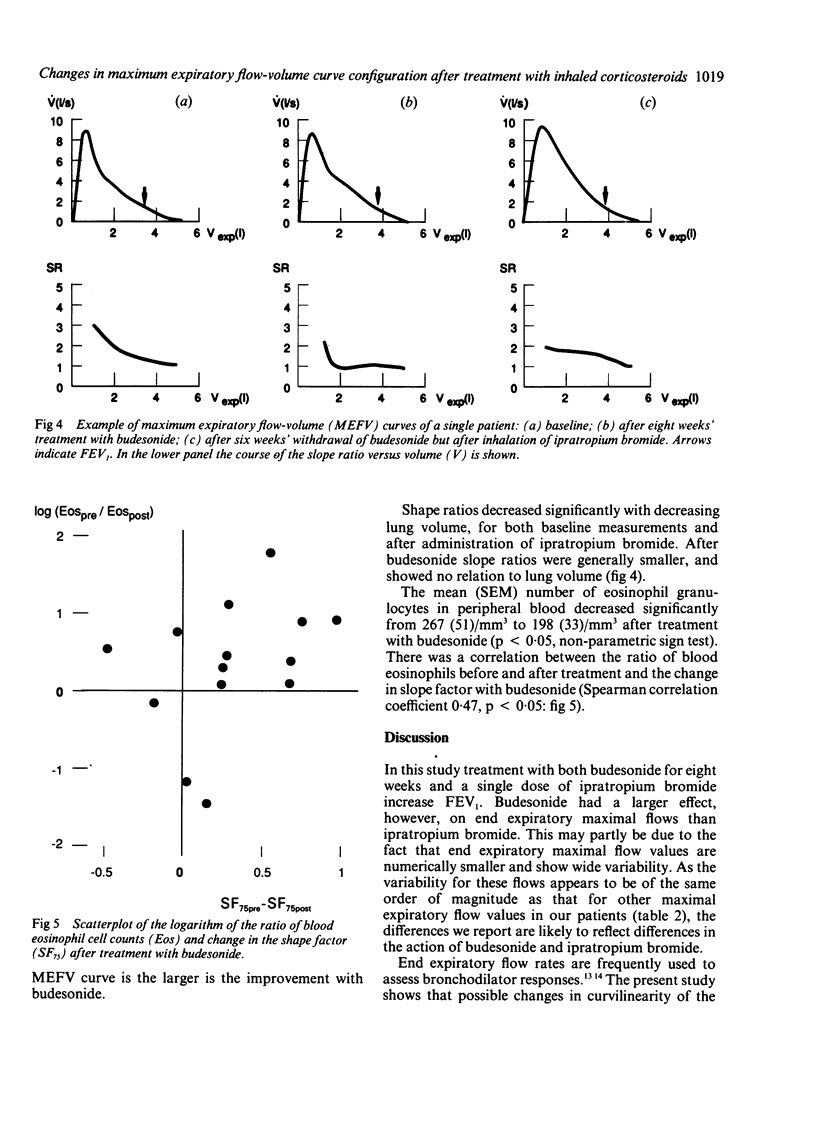
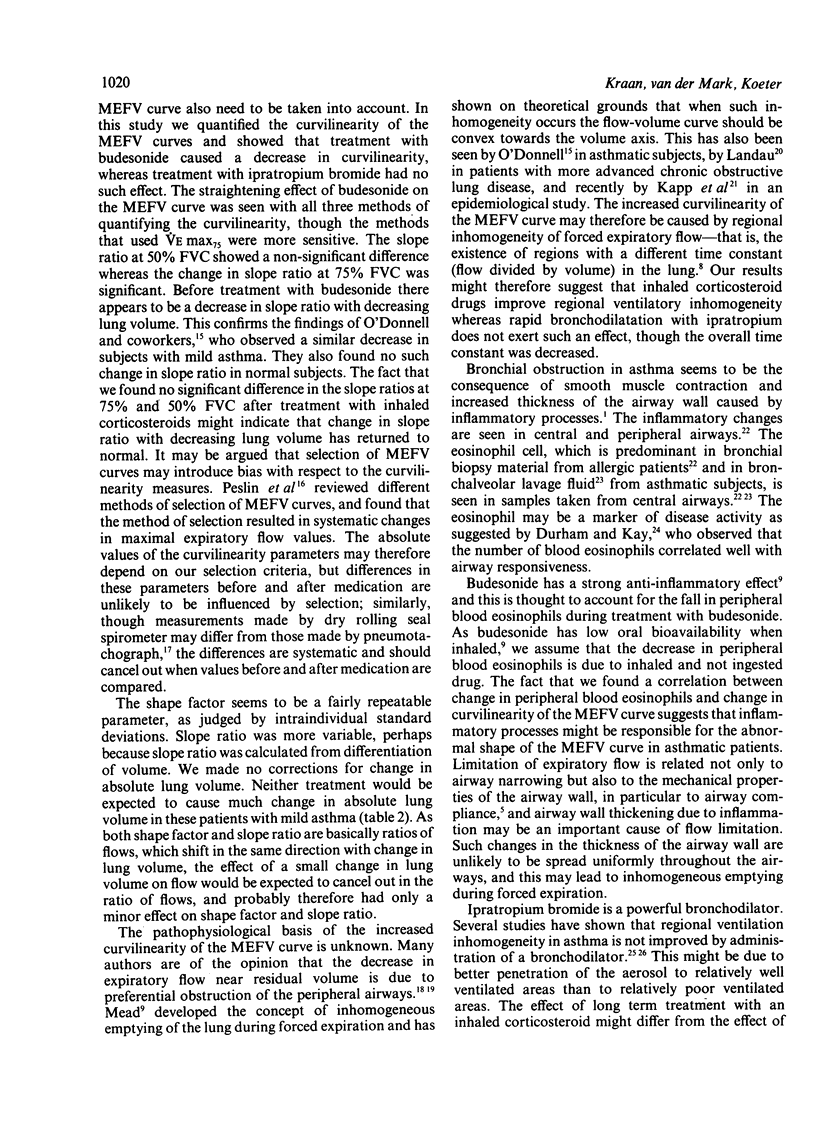
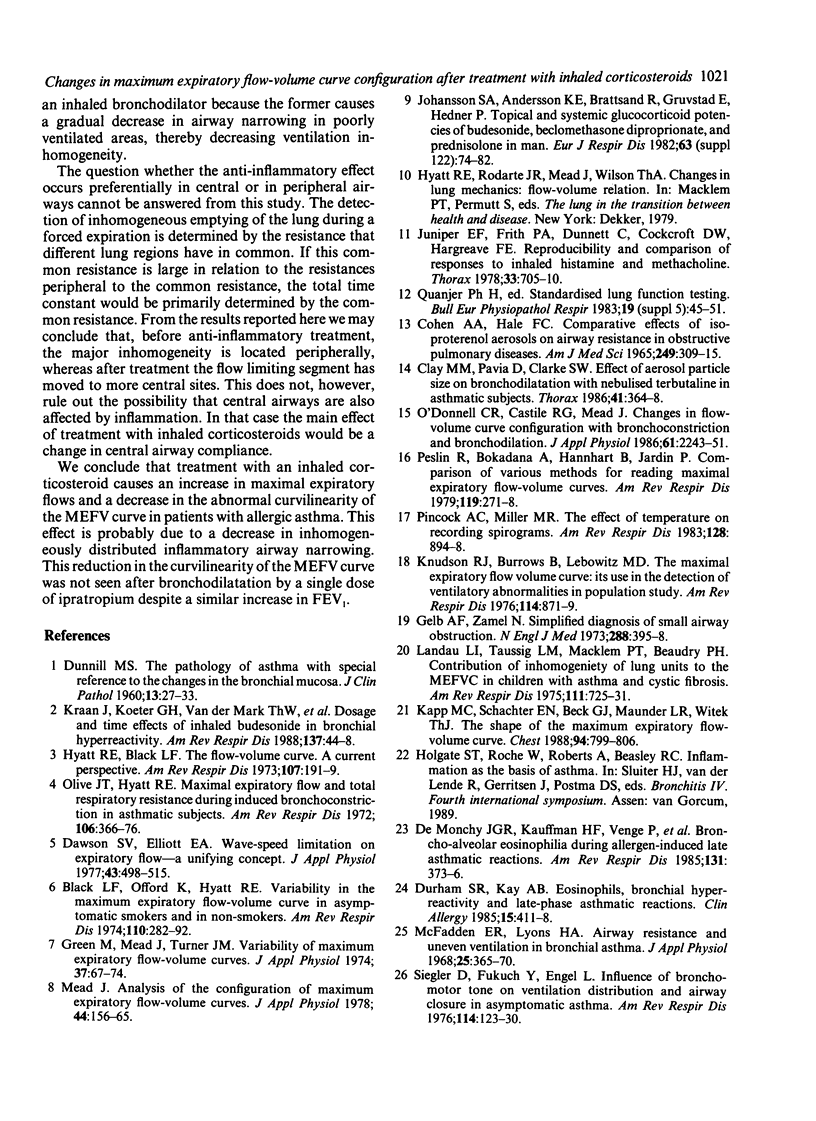
Selected References
These references are in PubMed. This may not be the complete list of references from this article.
- Black L. F., Offord K., Hyatt R. E. Variability in the maximal expiratory flow volume curve in asymptomatic smokers and in nonsmokers. Am Rev Respir Dis. 1974 Sep;110(3):282–292. doi: 10.1164/arrd.1974.110.3.282. [DOI] [PubMed] [Google Scholar]
- COHEN A. A., HALE F. C. COMPARATIVE EFFECTS OF ISOPROTERENOL AEROSOLS ON AIRWAY RESISTANCE IN OBSTRUCTIVE PULMONARY DISEASES. Am J Med Sci. 1965 Mar;249:309–315. doi: 10.1097/00000441-196503000-00010. [DOI] [PubMed] [Google Scholar]
- Clay M. M., Pavia D., Clarke S. W. Effect of aerosol particle size on bronchodilatation with nebulised terbutaline in asthmatic subjects. Thorax. 1986 May;41(5):364–368. doi: 10.1136/thx.41.5.364. [DOI] [PMC free article] [PubMed] [Google Scholar]
- DUNNILL M. S. The pathology of asthma, with special reference to changes in the bronchial mucosa. J Clin Pathol. 1960 Jan;13:27–33. doi: 10.1136/jcp.13.1.27. [DOI] [PMC free article] [PubMed] [Google Scholar]
- Dawson S. V., Elliott E. A. Wave-speed limitation on expiratory flow-a unifying concept. J Appl Physiol Respir Environ Exerc Physiol. 1977 Sep;43(3):498–515. doi: 10.1152/jappl.1977.43.3.498. [DOI] [PubMed] [Google Scholar]
- De Monchy J. G., Kauffman H. F., Venge P., Koëter G. H., Jansen H. M., Sluiter H. J., De Vries K. Bronchoalveolar eosinophilia during allergen-induced late asthmatic reactions. Am Rev Respir Dis. 1985 Mar;131(3):373–376. doi: 10.1164/arrd.1985.131.3.373. [DOI] [PubMed] [Google Scholar]
- Durham S. R., Kay A. B. Eosinophils, bronchial hyperreactivity and late-phase asthmatic reactions. Clin Allergy. 1985 Sep;15(5):411–418. doi: 10.1111/j.1365-2222.1985.tb02290.x. [DOI] [PubMed] [Google Scholar]
- Gelb A. F., Zamel N. Simplified diagnosis of small-airway obstruction. N Engl J Med. 1973 Feb 22;288(8):395–398. doi: 10.1056/NEJM197302222880805. [DOI] [PubMed] [Google Scholar]
- Green M., Mead J., Turner J. M. Variability of maximum expiratory flow-volume curves. J Appl Physiol. 1974 Jul;37(1):67–74. doi: 10.1152/jappl.1974.37.1.67. [DOI] [PubMed] [Google Scholar]
- Hyatt R. E., Black L. F. The flow-volume curve. A current perspective. Am Rev Respir Dis. 1973 Feb;107(2):191–199. doi: 10.1164/arrd.1973.107.2.191. [DOI] [PubMed] [Google Scholar]
- Johansson S. A., Andersson K. E., Brattsand R., Gruvstad E., Hedner P. Topical and systemic glucocorticoid potencies of budesonide, beclomethasone dipropionate and prednisolone in man. Eur J Respir Dis Suppl. 1982;122:74–82. [PubMed] [Google Scholar]
- Juniper E. F., Frith P. A., Dunnett C., Cockcroft D. W., Hargreave F. E. Reproducibility and comparison of responses to inhaled histamine and methacholine. Thorax. 1978 Dec;33(6):705–710. doi: 10.1136/thx.33.6.705. [DOI] [PMC free article] [PubMed] [Google Scholar]
- Kapp M. C., Schachter E. N., Beck G. J., Maunder L. R., Witek T. J., Jr The shape of the maximum expiratory flow volume curve. Chest. 1988 Oct;94(4):799–806. doi: 10.1378/chest.94.4.799. [DOI] [PubMed] [Google Scholar]
- Knudson R. J., Burrows B., Lebowitz M. D. The maximal expiratory flow-volume curve: its use in the detection of ventilatory abnormalities in a population study. Am Rev Respir Dis. 1976 Nov;114(5):871–879. doi: 10.1164/arrd.1976.114.5.871. [DOI] [PubMed] [Google Scholar]
- Landau L. I., Taussig L. M., Macklem P. T., Beaudry P. H. Contribution of inhomogeneity of lung units to the maximal expiratory flow-volume curve in children with asthma and cystic fibrosis. Am Rev Respir Dis. 1975 Jun;111(6):725–731. doi: 10.1164/arrd.1975.111.6.725. [DOI] [PubMed] [Google Scholar]
- Mead J. Analysis of the configuration of maximum expiratory flow-volume curves. J Appl Physiol Respir Environ Exerc Physiol. 1978 Feb;44(2):156–165. doi: 10.1152/jappl.1978.44.2.156. [DOI] [PubMed] [Google Scholar]
- O'Donnell C. R., Castile R. G., Mead J. Changes in flow-volume curve configuration with bronchoconstriction and bronchodilation. J Appl Physiol (1985) 1986 Dec;61(6):2243–2251. doi: 10.1152/jappl.1986.61.6.2243. [DOI] [PubMed] [Google Scholar]
- Olive J. T., Jr, Hyatt R. E. Maximal expiratory flow and total respiratory resistance during induced bronchoconstriction in asthmatic subjects. Am Rev Respir Dis. 1972 Sep;106(3):366–376. doi: 10.1164/arrd.1972.106.3.366. [DOI] [PubMed] [Google Scholar]
- Peslin R., Bohadana A., Hannhart B., Jardin P. Comparison of various methods for reading maximal expiratory flow-volume curves. Am Rev Respir Dis. 1979 Feb;119(2):271–277. doi: 10.1164/arrd.1979.119.2.271. [DOI] [PubMed] [Google Scholar]
- Pincock A. C., Miller M. R. The effect of temperature on recording spirograms. Am Rev Respir Dis. 1983 Nov;128(5):894–898. doi: 10.1164/arrd.1983.128.5.894. [DOI] [PubMed] [Google Scholar]
- Siegler D., Fukuchi Y., Engel L. Influence of bronchomotor tone on ventilation distribution and airway closure in asymptomatic asthma. Am Rev Respir Dis. 1976 Jul;114(1):123–130. doi: 10.1164/arrd.1976.114.1.123. [DOI] [PubMed] [Google Scholar]


